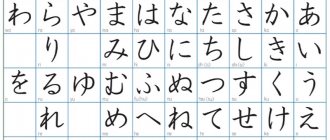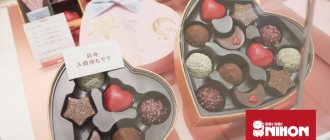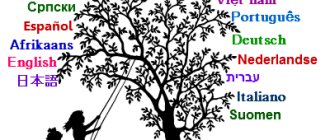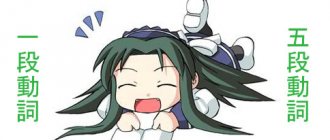Cases in Japanese - 10 cases in Japanese
This is a must-have topic for learning Japanese.
| Latin | Hiragana | Case | Question | |
| 1 | Ga | が | Nominative (rhematic) | Who what? |
| 2 | No | の | Genitive | Whose? Which? |
| 3 | Wo | を | Accusative | Who/what? |
| 4 | Ni | に | Dative | To whom; to what? From whom/what? Where? (with verbs of being) Where? When? |
| 5 | De | で | Instrumental | By whom/what? Where? (with active verbs) Of what? (with materials) |
| 6 | To | と | Joint | With whom/what? |
| 7 | E | へ | Case of direction | Where? |
| 8 | Kara | から | Original | Where? From what time? |
| 9 | Made | まで | Limit | To where? Until what time? |
| 10 | Yori | より | Initial-comparative | Regarding what? From whom? |
We will also consider a number of particles that are not cases, but often take on their function:
Wa (は) is an emphatic thematic particle.
Mo (も) is a particle meaning “also, also.”
Plural - Japanese
This lesson covers the following topics: Plural and simple forms, list of animals
. This course is designed to help you learn grammar and improve your vocabulary. Try to concentrate on the following examples as they are very important for learning the language.
Plural
Grammar Tips:
Plural and simple forms, list of animals are very important to learn because they are used in everyday communication. Try to remember the new words you have. Also try to write down words that you do not understand or expressions that you are not familiar with.
The following table provides some examples, please read them carefully and determine if you can understand them.
| Plural | Plural |
| Plural | fukusuu —複数 |
| my book | watashi no hon -私の本 |
| my books | watashi no hon -私の本 |
| our daughter | watashi tachi no musume -私達の娘 |
| our daughters | musume tachi no musume —娘たちの娘 |
| I'm cold | samui desu ne —寒いですね |
| we're cold | samui desu ne —寒いですね |
| his chickens | kare no niwatori |
| their chicken | karera no niwatori |
You are finished with the first table. Did you notice any grammatical patterns? Try to use the same words in different sentences.
Plurals - Expressions
The following table will help you understand this topic more deeply. It's important to remember any new words you come across because you'll need them later.
| Plural | Plural |
| crocodile | wani —ワニ |
| crocodiles | wani —ワニ |
| bear | kuma —熊 |
| the Bears | kuma —熊 |
| bird | tori -鳥 |
| birds | tori -鳥 |
| bull | ushi -牛 |
| bulls | ushi -牛 |
| cat | neko -猫 |
| cats | neko -猫 |
| cow | ushi -牛 |
| cows | ushi -牛 |
| deer | shika -鹿 |
| Many deer | ooku no shika —多くの鹿 |
| dog | inu -犬 |
| dogs | inu -犬 |
| donkey | roba -ロバ |
| donkeys | roba -ロバ |
| eagle | washi -ワシ |
| eagles | washi -ワシ |
| elephant | zoo -象 |
| elephants | zoo -象 |
| giraffe | kirin —キリン |
| giraffes | kirin —キリン |
| goat | yagi -ヤギ |
| goats | yagi -ヤギ |
| horse | uma -馬 |
| horses | uma -馬 |
| a lion | raion —ライオン |
| lions | raion —ライオン |
| monkey | saru —サル |
| monkey | saru —サル |
| mouse | mezumi -メズミ |
| mice | mezumi -メズミ |
| rabbit | usagi —ウサギ |
| rabbits | usagi —ウサギ |
| snake | hebi -ヘビ |
| snakes | hebi -ヘビ |
| tiger | tora —虎 |
| tigers | tora —虎 |
| wolf | ookami —オオカミ |
| wolves | ookami —オオカミ |
We hope this lesson helped you with grammar and vocabulary on the topic: Plural and simple forms, list of animals. We also hope that you now have no difficulties using them. After completing this lesson, you can go to the main page using this link and select other courses: Study - Japanese
| Lessons: | Alphabet | Phrases | Adjectives |
| Japanese | Numbers | Verbs | Expressions |
| Home page | Prepositions | Translation | Keyboard |
The links above are just a small sample of our lessons. Open the menu on the left to see all the links.
Cases in Japanese - Genitive NO (の)
➀ Answers whose question? Which? Marks affiliation.
Watashi no kutsu
My shoes
Gakusei no pen
Student pen
Note that in Japanese the definition always comes before the word being defined.
➁ In addition, の can be used in cases where we are talking about the content of an information medium, such as a book, textbook, dictionary, magazine, cassette, disk, etc.:
Nihongo no jisho
Japanese Dictionary
➂ There is also a use that is completely uncharacteristic for the Russian language - an explanation of who the person we are talking about is:
友だちの田中さん Tomodachi no Tanaka-san
Friend Tanaka (= Tanaka who is a friend)
The basic relations of belonging expressed by the case の
a) Relationships between an object and a person:
- せんせいのつくえ – teacher’s table (literally, who’s table?
teacher). The Word table つくえ is a noun A (the main or qualified word) according to our scheme, and the Word teacher せんせい is a noun B (the definition to which the main qualified word belongs). Analyze each of the phrases below in the same way by writing or speaking. - わたしのほん – my book (literally, who’s book?
) - あのひとのぼうし – his (or her) hat (literally, who’s hat?
her/his)
b) The relationship between an object and another object
- くるまのかぎ car keys (literally, the keys of what?
a car)
c) Relationship between a person and an object (school, company, country, etc.):
- がっこうのせいと – school student (student of what?
school)
d) Relationships of belonging of one object to another object:
- きょうしつのまど– audience window (window of what?
audience) - だいがくのしょくどう – university canteen ( what?
university canteen)
e) Relationships between a person belonging to another person:
- わたしのともだち – my friend.
Please note that we always start translation with the second noun in the phrase.
There are more variations of defining relations. For example, in the following examples, relations of tangency are conveyed (and not relations of belonging of a specific object or person to another object or person):
- ことばのいみ – meaning of the word (meaning (いみ) of what?
words (ことば)) - にほんごのせんせい – Japanese language teacher (teacher of what?
Japanese language) - もんだいのかいけつ – solution to a problem (solution (かいけつ) to what?
problem (もんだい)) - にぶんのいち – fraction ½ (one half) (one what?
two parts) - にほんごのべんきょう– studying the Japanese language (studying what?
Japanese language)
Our card for better memorization of the topic Genitive case in Japanese
:
In the process of learning the Japanese language, encountering more and more interesting phrases and sentences, you will gradually notice and remember the variety of uses of the genitive case, certain semantic nuances that are expressed with its help in the Japanese language, in each specific context. Thus, completely different nouns can connect the genitive case の, but the semantic essence of the case and the basic scheme for transferring belonging (in the most general sense) of Noun A to Noun B always remain unchanged.
Accusative case WO (を)
➀ Answers the question “who/what?” and is used with transitive verbs, for example:
テレビを見る。Terebi wo miru.
Watch TV.
➁ Also, the accusative case suffix WO (を) is used with some intransitive verbs that denote movement on a surface, for example:
公園を散歩する。Kouen wo sampo suru.
Walk in the park.
空を飛ぶ。Sora wo tobu.
Fly across the sky.
➂ And finally, WO (を) is used when we leave somewhere:
部屋を出る。Heya wo deru.
Escape from.
Japanese cases
1. Two nominative cases.
There are two nominative cases in Japanese, and both of them answer the same questions: who? or what?
2. Genitive case.
This case is formed using the particle の, pronounced "But". Nouns in this declension correspond to questions of belonging: whose?, which?, which differs from the traditional genitive case of the Russian language.
The peculiarity of the construction of phrases lies in the position of the definition in the sentence. Both pronouns and nouns act as definitions, and they are always placed before the object requiring characterization.
学生のペン – student’s pen.
This case also indicates the contents of the information carrier - book, disk, newspaper:
日本語の辞書 – Japanese language dictionary or Japanese dictionary, if verbatim.
3. Accusative case
This case, classical in our understanding, gives an answer to the questions of whom?, what?, and is denoted by the particle を – Vo.
Nouns in the accusative case are combined with transitive verbs: watch, listen, read and others:
テレビを見る – watch TV.
本を読む – read a book.
Second application: in combination with intransitive verbs in sentences talking about movement:
森の中を歩く – walk through the forest.
通りを歩く – walk down the street.
Third option: go out from somewhere.
家を出る – leave home.
The most common and multifunctional case is indicated by the particle に - Neither, and in addition to the usual ones?. to what?, also characterizes additional aspects: from whom?, from what?, where?, where? and when?
私は友人にそれを与えた – I gave it to a friend.
友達にもらいました – received from a friend.
猫は家の中にいます – a cat in the house.
It also answers the question when?, if the phrase contains days of the week or numbers indicating time:
5時に始まります – starts at 5 o’clock.
5. Instrumental case.
The case is formed by the hieroglyph で – “De”, and in addition to the usual by whom?, what?, it also answers the questions where?, or from what?
私は鉛筆で描く – I draw with a pencil.
私はオフィスで働いています– I work in an office.
Additionally, this case is used in constructions with quantitative characteristics:
二人で行きました – the two of them came.
6. Compatible or combining case.
The particle と – “That” after nouns puts them in a form that answers the questions with whom?, with what? By analogy with the Russian language, the particle is translated as the preposition “s” or the conjunction “and”.
猫と犬 – cats and dogs or cats and dogs.
妹と遊びます – I play with my younger sister.
This is one of the most understandable and logical cases in Japanese.
7. Case of direction.
The particle へ is read as “E” and puts the noun in a directive form, answering the question: where?, less often to whom? It is used only in nouns next to verbs denoting movement or movement: go, go, fly.
東京へ行きます – I’m going to Tokyo.
図書館へ行く – go to the library.
Also one of the most accessible, both in application and in the perception of cases.
This declension is formed by the case particle から – “Kara”, and logically denotes the initial conditions of actions: come from where?, wait from what time?
In Russian, these declensions are realized by the prepositions “iz”, “s”, “from” and the corresponding endings of nouns.
The original case is used in sentences telling about an action in some place or time:
公園から行きます – I’m coming from the park.
私は5時から働いています – I work from 5 o’clock.
May also apply to source material or condition:
寿司は魚から作られています – sushi is made from rice.
9. Limit case.
The particle まで – “Made” after nouns indicates any boundaries or limits, both in relation to space and in cases when it comes to time:
学校まで行きます – I’m going to school. (not to school, but to the school building, for example: I walk to school, and then take the bus.)
私は3時間まで勉強しました – I studied until three o’clock.
10. Initial comparative
The most unusual case in our understanding, since for the most part it refers not to nouns, but to adjectives. The reason is that the Japanese do not have comparative degrees in their speech: beautiful - more beautiful; big bigger. Such a comparison is formed by the particle より- “Yori”, and gives an answer to the questions: regarding what?, from whom?, in comparison with whom/what?
大阪は東京よりも小さい – Osaka is smaller than Tokyo.
This case is also used to indicate the author of the letter:
You can study cases in Japanese in more detail in our online Japanese courses. By the way, our teachers explain other complex but important topics in a way that is clear and accessible to everyone. For example, phonetics in Japanese or Japanese substantivators.
The Japanese language is not as difficult as it seems at first glance, and with the right approach, learning it can be made quick and accessible.
Source
Dative case NI (に)
This is perhaps the richest Japanese case in its use.
➀ Answers the question “to whom/what?”
猫にやりました。Neko ni yarimashita.
Gave it to the cat.
➁ Answers the question “from whom/from what?”
Tomodachi ni moraimashita.
Got it from a friend.
➂ Answers the question “where?” and is used with such verbs of being as the verbs imasu (います, to be), arimasu (あります, to be about inanimate objects) and sunde imasu (すんでいます, to reside):
犬は家にいます。Inu wa ie ni imasu.
The dog is in the house.
➃ Answers the question “where?” and is used with verbs of motion such as ikimasu (いきます, to go, go, leave, leave), kimasu (きます, to come, to come), kaerimasu (かえります, to return to one’s home), modorimasu (もどります, return), etc.:
アメリカに帰った。Amerika ni kaetta.
Returned to America.
➄ Answers the question “when?” and is used with those time indicators that have a number, as well as with days of the week:
8時に始まります。Hachiji ni hajimarimasu.
Starts at 8 o'clock.
Number
Most often, Japanese nouns do not specifically express singular or plural. Therefore, the sentence 車が走っている Kuruma ga hasitte iru can be translated both as “the car is moving” and as “cars are driving.”
However, to differentiate the meaning, there are still some cases of plural formation. For example, in Japanese legal documentation it is indicated after the noun: “plural”. In addition, there are the following ways to form the plural:
Reduplication (doubling) of a noun
It cannot be strictly called a method of plural formation, since during reduplication the word can have a completely different meaning, as in the last two examples. When doubling, a repeat icon is written instead of the second hieroglyph.
国 kuni - country, 国々 kuniguni - countries (here, when two roots are added, assimilation occurs)
山yama - mountain, 山々yamayama - mountains
人 hito - person, 人々 hitobito - people (here the assimilation of the consonant occurs during addition)
日hi - day, 日々hibi - daily, day after day
年 nen year, 年々nenne - annually
Prefixes
Prefixes 諸 sho - plural. ch, 各 kaku - each, 数 su: - several, etc. are added to words of Chinese origin. (see more details Suffixes and prefixes in complex kango)
諸君 shokun - gentlemen, you 各国 kakkoku - every country, all countries (when suffixes are added, assimilation occurs)
Instrumental case DE (で)
➀ The instrumental case DE (で) answers the question “by whom/what” and marks the instrument of action, for example:
日本人は魚を箸で食べる。Nihonjin wa sakana wo hashi de taberu.
The Japanese eat fish with chopsticks.
➁ Also, the instrumental case DE (で) answers the question “where” and marks the space in which the action is performed. Used with active verbs (i.e. almost all verbs except imasu (います), arimasu (あります) and sunde imasu (すんでいます)).
教室で勉強します。Kyoushitsu de benkyou shimasu.
I study in the classroom.
➂ Another interesting function of the instrumental case DE (で) is its use with quantity. For example, it can be used with a number of people, indicating "how many" an action was performed (two people, alone, etc.):
二人で行きました。Futari de ikimashita.
Let's go together.
Or, for example, how much money the product was purchased for:
300円で買った。Sambyakuen de katta.
Bought it for 300 yen.
➃ In addition, the instrumental case DE (で) will indicate the material from which the object is made, in the event that this original material is visible to the naked eye:
Kono isu wa afurika no ki de tsukurareta.
This chair was made from African wood.
In case the raw material is changed so much that we no longer see it. For example, we know that sake is made from rice, but it is a clear liquid with no rice inside - then we will use the original case KARA (から), which will be presented below.
Genus
Unlike Russian and German, in Japanese the concept of gender of nouns and verbs is practically absent. However, there are animate nouns and personal pronouns that, due to their meaning, express the male or female gender, for example, 女 onna - woman, 男 otoko - man, 父 titi - father, 母 haha - mother, じい ji: - grandfather, ばあ ba : - grandma, 彼 kare - he, 彼女 kanojo - she, etc. There are also different words that attach the same suffixes to denote female or male gender, mainly among kinship terms:
おじい oji: - grandfather, おばあ both: - grandmother
おじ oji - uncle, おば both - aunt
むすこ musuko - son, むすめ musume - daughter
あに ani - older brother, あね ane - older sister
おとこ otoko - man, おとめ otome - woman
There are also words that do not themselves express belonging to a particular gender, but only by adding suffixes (for example, お o- - male, め me - female) or words denoting one or another gender:
母親haha oya - mom, 父親titi oya - dad
雄鳥on dori - rooster, めんどりmen dori - chicken
雄牛o wushi - bull, 雌牛me wushi - cow
Direction case E (へ)
➀ Answers the question “where” and is used with verbs of motion:
図書館へ行く。Toshokan e iku.
Go to the library.
In this function it practically coincides with the accusative case NI (に). And although they are interchangeable in almost all cases, the NI (に) case is more likely to indicate the final destination of arrival, while when we put the E (へ) case, the emphasis is more on the path to that place. In other words, in the example above, we could go out in the direction of the library, but whether we get there or sit down on the way to eat ice cream and admire the birds is another question!
Features of noun declension in Japanese
We know that there are only 6 cases in the Russian language, and this is quite enough to implement any verbal constructions. Declension of nouns, prepositions and adjectives when constructing sentences according to the rules of the Russian language is carried out using changing endings and prepositions.
In Japanese, the principle of constructing phrases with additional parts of a sentence is significantly different from what we are used to. Therefore, there are much more cases in it.
Japanese nouns are not inflected. More precisely, they decline, but at the same time the word itself is a stable dictionary form.
To inflect nouns, the Japanese use case particles, also called suffixes. Particles are placed immediately after the noun in the initial form. As we found out above, this form is the only one.
The case particle cannot be considered an ending, by analogy with the Russian language. This is a separate part of speech, indicated by the corresponding symbol. But in oral speech, such particles are adjacent to nouns, united by a single intonation.
Let's take a closer look at how many cases there are in Japanese, and how they are implemented in practice.
Cases in Japanese for comparison
Original comparative case YORI (より)
➀ Answers the question “relative to what?”, “in comparison with what?”.
The suffix of the original comparative case YORI (より) is used to construct comparative constructions for adjectives. The fact is that Japanese adjectives do not have a comparative degree. We can say "big" - ookii (おおきい), but the word "bigger" simply does not exist in Japanese. But we still need to compare, otherwise how will we know whose grass is greener and whose sky is bluer. Therefore, in Japanese we can indicate in relation to what an object is large. For this we will use the suffix of the original comparative case YORI (より):
Tokyo wa Osaka yori ookii desu.
Tokyo is bigger than Osaka. (=Tokyo is big compared to Osaka).
➁ In addition, it has one more function - actually, originality. In this it is similar to the KARA (から) case. This is a rather archaic usage and is currently used, perhaps, only in letters:
Yamada yori
From Yamada
★★★
The question of correct placement of cases depends entirely on the verb and those constructions that are at the end of the sentence. It is important to understand that nouns themselves do not need cases, in other words, while a chair is just a chair existing in space, it does not need cases. Cases will appear when we see this chair, sit on it, go to it, etc., that is, this or that control will appear. In this regard, it is very important to pay attention to which cases a particular verb is combined with and remember verbs either with a case, or even in conjunction with a noun. For example, the verb AIMASU (会います), "to meet" will be ruled either dative NI (に) or collateral TO (と):
友達と会った。 Tomodachi to atta.
Met a friend.
熊に会った。Kuma ni atta.
Encountered a bear
Cases in Japanese are the basis for forming sentences, so you need to master this topic to communicate competently.
What are declensions in Japanese?
Despite the fact that Japan is a small island country, the language of these parts is very widespread in the world. The carriers of this means of communication are literally scattered all over the globe, and the popularity of studying it is growing every day. This can be explained by the rich unique culture of this people, as well as the high standard of living and technological development. And considering the question of what declensions are in Japanese may be useful.
Cases or particles?
An interesting fact is that the Japanese themselves doubt how declension occurs - by cases or by adding particles. Some philologists from the Land of the Rising Sun have adopted the point of view that this process occurs by the type of substitution of certain letter symbols (particles). And the other half of linguists are of the opinion about the presence of case endings. To understand what declensions are in the means of communication of the Japanese, we will take the side of the latest linguistic experts.
Japanese cases
Case declension in Japanese is carried out with the addition of particles. There are several categories:
- The nominative thematic case is formed using the suffix は, thematic - が. The difference between these two categories is that the subject is given different shades. For example, 青木さんは ぎしです。Here the semantic emphasis is on the fact that Mr. Aoki is an engineer. Whereas in the next sentence, the engineer is precisely (of all those present) Mr. Aoki - 青木さんが ぎしです。.
- The genitive case has two meanings - belonging and attribute of an object, and the particle の is used. For example, かみの (paper).
- The dative case determines the direction of movement and location of the object, and also denotes the moment in time with the addition of the particle に. To understand what declinations are in this category, we give the following examples: 手を上に (palms up), 十時にねます。 (I go to bed at 10 o’clock), 私は部屋にいます。 (I am in the room).
- In the accusative case, the noun acts as a direct object, and the symbol marking this meaning is を. For example, かおをあらいます。 (to wash).
- The instrumental case is used to determine the subject (object) by which an action is performed, as well as to indicate the place of action (which is slightly different from the case form of the Russian language). Thus, in the combinations “speak Japanese” (日本語で話す) and “buy a book in a store” (本屋で本を買います。), one particle で is used.
- The case of direction is formed by the particle へ, for example 東京へ行きます。(I’ll go to Tokyo).
- The joint case denotes an action with someone, for example, 私は妹と学校へ行きます。(I am going to school with my younger sister). It can be noted that the declension of proper names in this category is also formed with the particle と.
- Initial-comparative and initial-limiting categories are performed using these constructions “から – より” and “から –まで”. For example, 青木さんは私より背がたかいです。(Aoki is taller than me).
Knowing what declensions are in Japanese, you can make simple sentences and gradually develop your speaking skills. The rules for adding category particles are very simple - you just need to substitute them after the word without any changes. The noun itself also remains in its initial form, only the predicate changes.
Accusative case を(wo)
The accusative case is the only one of all that has its own sign, it is read as “o”, but if you want to print it in Japanese, then print “wo”.
There are several functions of the accusative case WO (を):
1 Shows the object on which the action is being performed.
Ban-gohan wo taberu. - There is dinner.
2 The place from which someone/something comes out, the starting point of movement.
Minato wo deru. – Leave the port.
3 Indicates the space through which movement occurs, translated as “through.”
Michi wo aruku - Walk along the road.
Next we will see that the last function with the WO case is shared by the NI and DE cases. Let's move on to them.
Cases in Japanese. From simple to complex. Nominative thematic case (particle は/wa)
There are cases in the Japanese language, and in this article we will look at the indicator of the nominative thematic case - the particle は/wa.
The hiragana character は/ha (in case function read “wa”) is an indicator of the nominative thematic case in Japanese.
Situations for using the particle は/ha (wa) as a case are as follows:
1. は/wa is used when explaining or expressing any judgment:
2. は/ wa is used to indicate the speaker's thought:
3. は/wa is used to emphasize or intensify:
Let's look at all these situations along with examples:
1.1. The particle は/wa is used to indicate the main topic of a statement or explanation:
わたしは
田中です。Watashi wa Tanaka desu.
I am Tanaka. (name)
これは
本です。Kore wa hon desu.
This is a book. (definition)
Toshokan wa hon wo karitari yondari suru tokoro desu.
A library is a place where books are borrowed and read. (definition)
雪は白いです。Yuki wa shiroi desu. Snow is white. (generally known truth)
一週間は七日です。Isshu:kan wa nanoka desu. There are 7 days in a week. (generally known truth)
子供たちは公園です。Kodomotachi wa ko:en desu. The children (are) in the park. (expresses place)
スポーツは楽しいです。Supo:tsu wa tanoshii desu. Sport is enjoyable. (judgment)
Karaoke wa omoshirokunaidesu . _ Karaoke is not interesting. (judgment - negation)
彼は親切な人です。Kare wa sinsetsuna hito desu. - He is a kind person. (judgment)
1.2. To indicate the state of the topic of the statement ( ~は~が/
Yukiko san ga ookii desu . Yukiko has big eyes.
Tarou kun wa atama ga ii desu. Tarot is smart.
日本はものが高いです。Nihon wa mono ga takai desu. Things are expensive in Japan.
Kono gakkou gakusei ga ooi desu. There are many students in this school.
1.3. To explain and compare two sayings ( A
は ~、 Bは~ / A wa
りんごは好きですが、バナナはきらいです。Ringo wa suki desu ga, banana wa kirai desu.
I like apples, but I don't like bananas.
Sakana wa tabemasu ga , wa tabemasen. I eat fish, but I don’t eat meat.
Ryoushin imasu ga kodomotachi wa ni imasu. The parents are in Osaka and the children are in Tokyo.
Ane wa pinpon : ga , oto:to wa pianisuto desu. The older sister plays table tennis, and the younger brother is a pianist.
1. If the subject is mentioned for the second time in a conversation
Tonari no ie inu ga imasu . Sono inu wa
Shirokute kawaii desu. There is a dog in the neighboring house. This (that) dog is cute.
Kinou tomodachi ni aimasita . Sono tomodachi wa raishuu Hawai ni ikimasu. Yesterday I met a friend. This friend is going to Hawaii next week.
2.2. To indicate a narrower topic
Ano wa dare no desu ka? Whose is that beautiful hat?
Kino eiga wa totemo omoshirokatta desu. The film I watched yesterday was interesting.










